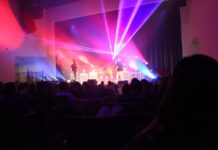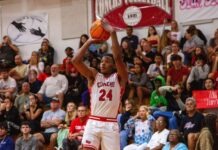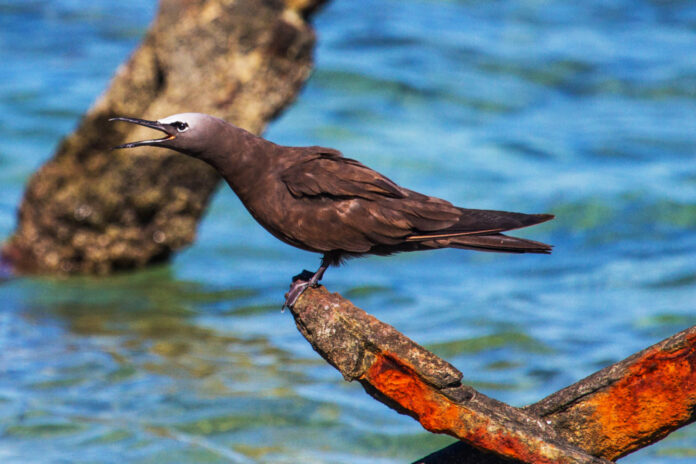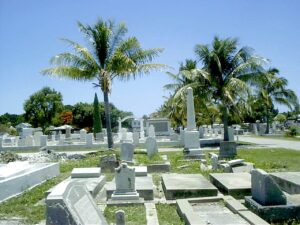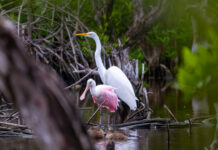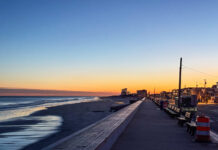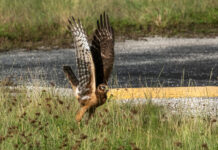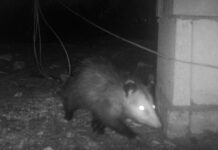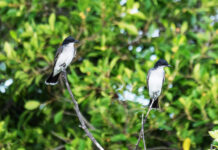Fall migration was in full swing, and it had been a nice morning birding around Fort Zach. Warblers were flitting here and there, barn swallows and cave swallows were zooming overhead, and the occasional thrush would hop up onto an old log, give me a disappointed look and disappear into the shadows again.
All of this had been underscored by the U.S. Marines, or at least one Marine, though I didn’t know he was a Marine at the time. He was just a disembodied voice addressing subordinates through a megaphone for 45 minutes about how to get on and off an inflatable boat during a beach landing.
I thought it might have been Navy SEALs or Army Special Forces, but when I made it out to the beach I saw a boat just offshore with USMC on the side. Looking through the fence at JIATF I could see two or three black inflatable rafts in the shallows, and about 30 men standing in a long row on the beach. Occasionally one of the boats would make a foray a couple hundred yards offshore, then turn back.
After a while I turned my attention to the rocky breakwaters of the Fort Zach beach. Mostly you see gulls and pelicans there, but other interesting birds do occasionally make appearances. This morning, there was a snowy egret, with its austere white feathers, black legs and yellow starfish feet. There was also a black-bellied plover sans black belly, as the breeding season was over.
Something brown caught my eye as it flew low across the water from the beach to the middle pile of rocks. It was the size of a smallish gull or tern, and I quickly had my suspicions. Despite having used the same binoculars for more than 15 years, I rolled the focus wheel in the wrong direction at first – so much for muscle memory – then brought it back, then further back until the bird appeared sharp through the glass.
It was, in fact, a tern, a near-uniform chocolate brown one with a whitish cap on its head, which made it a brown noddy.
The kindest version of how brown noddies got their name is that it is derived from their mating rituals, in which the male and female approach each other on a beach or rocky cliffside, bowing their heads up and down, or nodding at each other. The less kind take is that, when the bird was first described to science in 1758, the word noddy meant a sleepy person, or more to the point, a simple and stupid person.
The brown noddy’s scientific name is Anous stolidus. Anous, when translated from ancient Greek, means foolish or stupid. Stolidus also comes from the ancient Greek, meaning insensible, dull and/or stupid. Calling a bird the “stupid stupidhead” just seems an unnecessarily pejorative and redundant use of taxonomic nomenclature, even if you wrap it up in a fancy dead language.
You could blame the lack of love in the naming department on the mindset of the naturalists of yore. But Ernest A. Choate, author of the often-fusty-but-sometimes-fun “Dictionary of American Bird Names” described all the derision as appropriate in the 1985 edition of his book. Why? The name was “given to the bird by sailors because it did not take alarm at their approach.”
Brown boobies tend to breed in out-of-the-way places. And when they are not breeding, they spend their life at sea, far from shore, often hundreds of miles from shore. Like their similarly-maligned pelagic avian cohorts in the booby genus (booby also means stupid) they don’t encounter a lot of humans, and therefore have not evolved to see them as a threat. They’re not stupid; they are unwary of humans, which in my book is not the same thing, even though it can bring about the same unfortunate results.
While I certainly don’t think brown noddies are intellectually challenged, I was wondering if the one on the rocks at Fort Zach might be ill.
Brown noddies are monogamous, though in bird world, monogamy is often only seasonal. Both the male and the female spend about four months on land raising a single chick every year, splitting brooding and food gathering duties pretty evenly. The chicks get fed so much that they are often heavier than their parents when they take their first flight, though that weight is usually burned off quickly. The other eight months of the year they fly around the tropical oceans of the world, looking for fish.
Brown noddies breed at the Dry Tortugas by the tens of thousands. It is actually the only place in North America they breed. Their colony on Bush Key – adjacent to Garden Key, where the fort is – is intermingled with that of the even more populous sooty tern, a species that is similarly unwary but doesn’t suffer similar derision in any of its names.
I’ve seen very few noddies near the mainline Keys – usually only if there is a storm – and I don’t think I’ve ever seen one land here. I have seen pictures of them here, but only on Facebook posts from the Key West Wildlife Center about birds that needed to be rescued. A species committed to the deep-ocean lifestyle generally doesn’t feel the need to land on nearshore rocks.
While I was watching it, the noddy hopped up and changed rocks once when a snorkeler swam close by. (See? Wary.) It moved again when a posse of laughing gulls landed around it.
I heard a build up of noise over on the JIATF beach and looked just as the rafts took off from the beach, headed out towards the open water, then turned and aimed towards Key West Harbor, followed by the larger USMC boat. I tracked them until they were out of sight, then turned back to the rocks.
I couldn’t find the brown noddy. The bird was actually pretty close to the same color as the rocks, so I took my time, scanning each rock carefully, then the rocks on the other breakwaters.
It was gone, which I hoped meant the bird was just having an adventure, trying out the nearshore waters lifestyle, and was actually pretty healthy.
A few minutes later a brown pelican flew slowly down the beach, angled up, then augered in and splashed into the same waters the Marines had recently occupied. The pelican looked to have caught itself a nice mouthful of fish.

